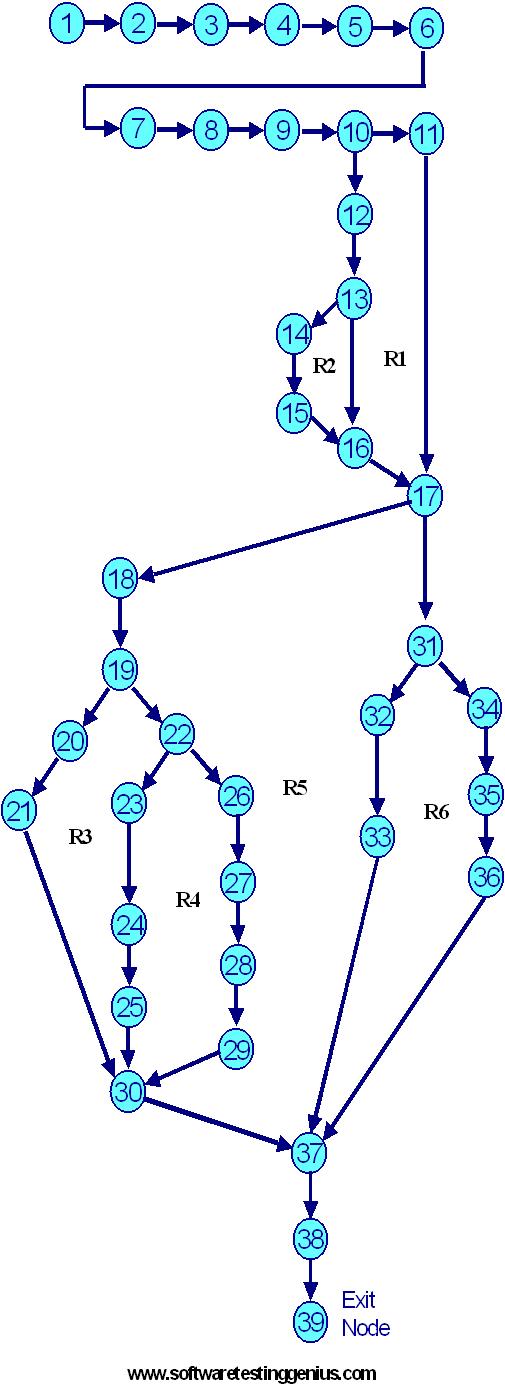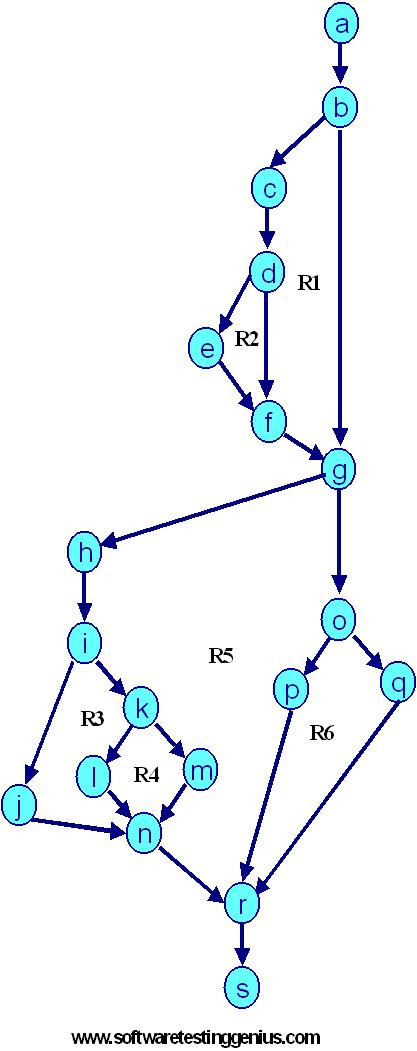Tutorial-6: DD Path Testing: Case of a Quadratic Equation
Objective of the Tutorial: To draw a Flow Graph, a DD Graph, calculation of Cyclomatic Complexity V(G) and find out all independent paths from the DD paths graph, for the case of quadratic equation ax2 + bx + c = 0 where three coefficients a, b and c roots are calculated. The output may be real roots, imaginary roots or equal roots or even the equation may not be a quadratic equation.
When we have a flow graph, we can easily draw another graph that is known as decision-to-decision or (DD) path graph, wherein we lay our main focus on the decision nodes only. The nodes of the flow graph are combined into a single node it they are in sequence.
Process of constructing the DD Graph leading to computation of Cyclomatic Complexity goes like this:
Step 1: Start writing the following program
# include
# include
# include
(1) int main ( )
(2) {
(3) int a, b, c, d, boolean = 0;
(4) double D;
(5) printf (�nt Enter `a’ coefficient :”);
(6) scanf (“%d”, & a) ;
(7) printf (“nt Enter `b’ coefficient :�);
(8) scanf (“%&d”, & b);
(9) printf (�nt Enter `c’ coefficient :�);
(10) scanf, (“%d�, & c) ;
(11) if ((a > =0) && (a < = 00) && (b > = 0) && (b < =100) && (c > =0) && (c < =100)) {
(12) boolean = 1;
(13) if (a = = 0) {
(14) boolean = -1;
(15) }
(16) }
(17) if (boolean = = 1) {
(18) d = b * b � 4 * a * c;
(19) if (d = = 0) {
(20) printf (“roots are equal and are r1= r2 = %f – b/(2 * float)&));
(21) }
(22) else if (d > 0) {
(23) D = sqrt (d);
(24) printf (“roots are real and are r1=%f and r2=%f; (-b – D)/(2 * a), (-b + D)/(2 * a));
(25) }
(26) else {
(27) D = sqrt (-d) / (2 * a);
(28) printf (“roots are imaginary”);
(29) }
(30) }
(31) else if (boolean = = -1) {
(32) printf (“Not a quadratic equation”);
(33) }
(34) else {
(35) printf (“Invalid input range …);
(36) }
(37) getch ( ):
(38) return 0;
(39) }
Step 2: Draw the following Flow Graph

Step 3: Draw the following DD Path Graph

Since, nodes 1-10 are sequential nodes in the above flow graph, hence they are merged together as a single node � �a�.
Since node ��11� is a decision node, thus we cannot merge it any more.
Likewise we can go on deciding the merging of nodes & arrive at the following DD Path Graph
We get following decision table.
| Nodes in Flow Graph | Corresponding Nodes of DD Path Graph | Justification |
| 1- 9 | a | Are Sequential Nodes |
| 10 | b | Decision Nodes |
| 11 | c | Decision Nodes |
| 12, 13 | d | Sequential Nodes |
| 14 | e | Two Edges Combined |
| 15, 16, 17 | f | Sequential Nodes |
| 18 | g | Decision Nodes |
| 19 | h | Decision Nodes |
| 20, 21 | i | Sequential Node |
| 22 | j | Decision Node |
| 23, 24 | k | Sequential Node |
| 25, 26, 27 | I | Sequential Nodes |
| 28 | m | Three Edges Combined |
| 29 | n | Decision Node |
| 30, 31 | o | Sequential Node |
| 32, 33, 34 | p | Sequential Nodes |
| 35 | q | Three edges Combined |
| 36, 37 | r | Sequential Exit Nodes |
Step 4: Calculation of Cyclomatic Complexity V(G) by three methods
Method 1: V(G) = e � n + 2 ( Where �e� are edges & �n� are nodes)
V(G) = 24� 19+ 2 = 5 + 2 = 7
Method 2: V(G) = P + 1 (Where P � No. of predicate nodes with out degree = 2)
V(G) = 6 + 1 = 7 (Nodes d, b, g, I, o & k are predicate nodes with 2 outgoing edges)
Method 3: V(G) = Number of enclosed regions + 1 = 6+1=7
( Here R1, R2, R3, R4, R5 & R6 are the enclosed regions and 1 corresponds to one outer region)
V(G) = 7 and is same by all the three methods.
Step 5: Identification of the basis-set with Seven Paths
| Path 1: | a � b � f � g � n � p � q � r |
| Path 2: | a � b � f � g � n � o � q � r |
| Path 3: | a � b � c � e � g � n � p � q � r |
| Path 4: | a � b � c � d � e � g � n � o � q � r |
| Path 5: | a � b � f � g � h � i � m � q � r |
| Path 6: | a � b � f � g � h � i � k � m � q � r |
| Path 7: | a � b � f � g � h � j � l � m � q � r |
Conclusions from the above tutorial:
Conclusion 1: Each of these paths consists of at least one new edge. Hence this basis set of paths is NOT unique.
Conclusion 2: Test cases should be designed for the independent path execution as identified above.
Conclusion 3: We must execute these paths at least once in order to test the program thoroughly.
Many more Articles & Tutorials on White Box Testing

An expert on R&D, Online Training and Publishing. He is M.Tech. (Honours) and is a part of the STG team since inception.

Why from 10 to 12,not 11 to 12?